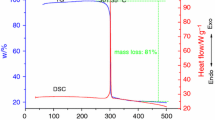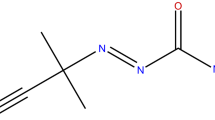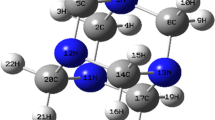Abstract
Ethylene oxide is a most versatile and critical raw chemical and intermediate. However, the strained ring of ethylene oxide is liable to be cleaved, potentially leading to industrial disasters at high temperatures, such as severe explosions, fires, and toxic releases. In this study, nonisothermal, adiabatic, and isothermal tests were performed to determine the inherent properties of aqueous ethylene oxide solution (AEOS) with regard to its safety. Differential scanning calorimetry and vent sizing package 2 were used to investigate its thermal decomposition and pseudo-adiabatic runaway reaction, respectively. Isothermally exothermic behavior was detected by using the thermal activity monitor IV. Kinetic equations were applied to calculate the apparent activation energy of AEOS (at conversion degrees of 10, 11, 12, 13,…, and 90%), with its value in the range 59.6–85.0 kJ mol−1. The Arrhenius method was also used to ascertain the frequency factor. As the conversion degree increased, the apparent activation energy and frequency factor gradually decreased. The flash point of AEOS was tested to determine its fire and explosion hazard potential. From the perspective of proactive loss prevention, these results are salient for the safer thermal handling of AEOS.









Similar content being viewed by others
Abbreviations
- A :
-
Frequency factor (s−1)
- C :
-
Reactant concentration (mol L−1)
- C 0 :
-
Initial concentration (mol L−1)
- \(\left( {{\text{d}}T\,{\text{d}}t} \right)_{\hbox{max} }^{ - 1}\) :
-
Maximum self-heating rate (°C min−1)
- \(\left( {{\text{d}}P\,{\text{d}}t} \right)_{\hbox{max} }^{ - 1}\) :
-
Maximum pressure rise rate (psig min−1)
- E a :
-
Apparent activation energy/kJ mol−1
- ΔH :
-
Heat of reaction (J g−1)
- k :
-
Reaction rate constant (min−1)
- \(k^{*}\) :
-
Pseudo-zero-order rate constant (min−1)
- m t :
-
Self-heating rate measured at time (t/ °C min−1)
- P max :
-
Maximum pressure (psig)
- R :
-
Gas constant/8.314 (J mol−1 K−1)
- T 0 :
-
Exothermic onset temperature (°C)
- T f :
-
Final temperature (°C)
- ΔT ad :
-
Temperature rise from initial to final reaction under the pseudo-adiabatic condition (°C)
- T p :
-
Peak temperature (°C)
- T iso :
-
Isothermal temperature (°C)
- T max :
-
Maximum temperature (°C)
- TMRiso :
-
Time to maximum rate under isothermal conditions (h)
- W p :
-
Peak normalized heat flow (W g−1)
- R 2 :
-
Correlation coefficient/dimensionless
- β :
-
Heating rate (°C min−1)
- n :
-
Order of reaction/dimensionless
- Φ:
-
Thermal inertia/dimensionless
References
Ghosh M, Godderis L. Genotoxicity of ethylene oxide: a review of micronucleus assay results in human population. Mutat Res. 2016;770:84–91.
Melhem GA, Gianetto A, Levin ME, Fisher HG, Chippett S, Singh SK, Chipman PI. Kinetics of the reactions of ethylene oxide with water and ethylene glycols. Process Saf Prog. 2001;20:231–46.
Rahimpour MR, Shayanmehr M, Nazari M. Modeling and simulation of an industrial ethylene oxide (EO) reactor using artificial neural networks (ANN). Ind Eng Chem Res. 2011;50:6044–52.
Zahedi G, Lohi A, Mahdi KA. Hybrid modeling of ethylene to ethylene oxide heterogeneous reactor. Fuel Process Technol. 2011;92:1725–32.
Nawaz Z. Heterogeneous reactor modeling of industrial multi-tubular packed bed ethylene oxide reactor using aspen custom modeler. Chem Eng Technol. 2016;39:1–14.
Britton LG. Thermal stability and deflagration of ethylene oxide. Plant Oper Prog. 1990;9:75–86.
Mihailidou EK, Antoniadis KD, Assael MJ. The 319 major industrial accidents since 1917. Int Rev Chem Eng. 2012;4:529–40.
Wang F, Zhao Y, Yang O, Cai J, Deng M. Process safety data management program based on HAZOP analysis and its application to an ethylene oxide/ethylene glycol plant. J Loss Prev Process Ind. 2013;26:1399–406.
You ML, Tseng JM, Liu MY, Shu CM. Runaway reaction of lauroyl peroxide with nitric acid by DSC. J Therm Anal Calorim. 2010;102:535–9.
Chen WT, Chen WC, You ML, Tsai YT, Shu CM. Evaluation of thermal decomposition phenomenon for 1,1-bis(tert-butylperoxy)-3,3,5-trimethylcyclohexane by DSC and VSP2. J Therm Anal Calorim. 2015;122:1125–33.
Chen WC, Shu CM. Prediction of thermal hazard for TBPTMH mixed with BPO through DSC and isoconversional kinetics analysis. J Therm Anal Calorim. 2016;126:1937–45.
Veedhi S, Mishra V, Kulkarni S, Gorthi R. Incident investigation on thermal instability of an intermediate using adiabatic calorimeter. J Therm Anal Calorim. 2014;115:909–14.
Wei JM, You ML, Chu YC, Shu CM. Evaluation of thermal hazard for lauroyl peroxide by VSP2 and TAM III. J Therm Anal Calorim. 2012;109:1237–43.
STARe software with Solaris operating system. Operating instructions. Stockholm: Mettler Toledo; 2017.
Chen WC, Chen WT, Wang YW, Chiu CW, Shu CM. Effects of mixing metal ions for the thermal runaway reaction of TMCH. J Therm Anal Calorim. 2014;118:1003–10.
Chou HC, Chen NC, Hsu ST, Wang CH, Wu SH, Wen IJ, Shen SJ, Shu CM. Thermal hazard evaluation of tert-butyl hydroperoxide mixed with four acids using calorimetric approaches. J Therm Anal Calorim. 2014;117:851–5.
Liu SH, Shu CM. Advanced technology of thermal decomposition for AMBN and ABVN by DSC and VSP2. J Therm Anal Calorim. 2015;121:533–40.
Liu SH, Hou HY, Chen JW, Weng SY, Lin YC, Shu CM. Effects of thermal runaway hazard for three organic peroxides conducted by acids and alkalines with DSC, VSP2, and TAM III. Thermochim Acta. 2013;566:226–32.
Liu SH, Chen YC, Hou HY. Thermal runaway hazard studies for ABVN mixed with acids or alkalines by DSC, TAM III, and VSP2. J Therm Anal Calorim. 2015;122:1107–16.
Phoon LY, Mustaffa AA, Hashim H, Mat R. Analysis of flash point predictions of tailor-made green diesel by UNIFAC group contribution methods. J Eng Sci Technol. 2015;10:110–9.
Lee MH, Chen JR, Das M, Hsieh TF, Shu CM. Thermokinetic parameter evaluation by DSC and TAM III along with accountability of mass loss by TG from the thermal decomposition analyses of benzoyl peroxide. J Therm Anal Calorim. 2015;122:1143–50.
Rebsdat S, Mayer D. Ethylene oxide. Ullmann’s Encyclopedia of Industrial Chemistry. 2012;547–72.
Mannan S. Lees’ loss prevention in the process industries. 4th ed. New York: Butterworth-Heinemann; 2012.
Crowl DA, Louvar JF. Chemical process safety. 3rd ed. New York: Pearson Education; 2011.
Rajeshwari P, Dey TK. Advanced isoconversional and master plot analyses on non-isothermal degradation kinetics of AlN (nano)-reinforced HDPE composites. J Therm Anal Calorim. 2016;125:369–86.
Pourmortazavi SM, Farhadi K, Mirzajani V, Mirzajani S, Kohsari I. Study on the catalytic effect of diaminoglyoxime on thermal behaviours, non-isothermal reaction kinetics and burning rate of homogeneous double-base propellant. J Therm Anal Calorim. 2016;125:121–8.
Townsend DI, Tou JC. Thermal hazard evaluation by an accelerating rate calorimeter. Thermochim Acta. 1980;37:1–30.
Lin CP, Tseng JM, Chang YM, Cheng YC, Lin HY, Chien CY. Green thermal analysis for predicting thermal hazard of storage and transportation safety for tert-butyl peroxybenzoate. J Loss Prev Process Ind. 2012;25:1–7.
Acknowledgements
The authors are indebted to the experimental assistance from the members at Process Safety and Disaster Prevention Laboratory in Taiwan and financial support by Nan Ya Plastics Corporation in Taiwan.
Author information
Authors and Affiliations
Corresponding authors
Rights and permissions
About this article
Cite this article
Sun, XX., Qin, SH., Lin, WC. et al. Thermal hazard studies on aqueous ethylene oxide solution using DSC, VSP2, and the pressure-proof TAM IV. J Therm Anal Calorim 133, 763–771 (2018). https://doi.org/10.1007/s10973-018-7279-7
Received:
Accepted:
Published:
Issue Date:
DOI: https://doi.org/10.1007/s10973-018-7279-7




